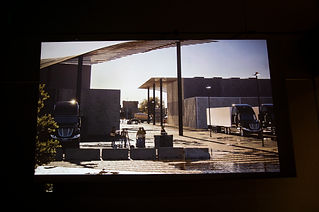

server farm in construction

view of server farm from the ruin

complete server farm

view of the ruin from server farm



the historic settlements across the northern coasts of Persian Gulf including five sites, and im focusing on mainly the kish island. These places are considered as a serial property consisting of the historic urban texture of the ports, coastal areas, tangible and intangible heritage that is directly related to the living cities, sea and their people.
Among all five of these historical ports, as most of their economy is still relying on the traditional fishery industry, Kish island is the only site with a modernized economic and architectural development while preserving the historical heritages and characteristics

Kish island started its development, and was designated as an industrial free trade zone in 1993 for the need of economic incentives. This development proposed an interesting relationship between this series of sites and within Kish island specifically. As Kish island became a FTZ within this series of WHS, the ruins of Harireh Ancient city on Kish island are still preserved and became a site for tourist attraction. This boundary between the old and new on Kish island creates an interesting situation and opportunity for the possibility of further development of the city.

In comparison to the rest of the fast developing FTZ around the world, Kish is not as well economically developed while its economy mainly depends on the tourism industry. So the architecture is built accordingly as well. By considering its history of being a trading port, it will be a direction of future development by introducing the new way of trading.
Kish Island site plan

By introducing the new online trading industry, the web 3 industry will attract the capitals and investments from the Middle Eastern enterprises. The land and architecture can be planned with the idea of being a replication of the historic trading function, with the characteristic, such as anonymity, collaboration, and decentralization. While the ancient trading city is not occupiable and inhabitable anymore nowadays, the architecture of web 3 industry seems to only exist virtually, and appears to be inhabitable as well.

By considering the architecture of such a virtually existing industry, the infrastructures and architecture of server farms relating to the online trading industry become one of the traces and human footprints of such a virtual reality world. The planning of the server farms across the island form this relationship between the past and the future with the identity of trading and inhabiting within the spaces.
As the land is divided into different layers of parcels, different enterprises with the need of building server farms relating to the web 3 industry will be able to occupy the island with various prototypes based on such as, the property value, the need of space, the practicability while different prototypes will be able to assemble on site with different prefabricated programs. By considering the effect of thermal pollution, there will be various forms of heat releasing roofs attached.

Section diagram of the relationship within site
With the introduction of this new industry and relating architecture, it pushes the relationship between the old and new further as the new city is being built on top of the old. The zone between the ancient city and the new city become the transportation route for ongoing excavating and preserving of the WHS, and the construction of the expanding new city creates a boundary between the two.

Section diagram of the relationship between old and new

Section view of the server farm with the ruin

Section view of the server farm

site plan
programs of the server farm includes data center, generators, cooling systems, electricity, security, etc.

floor plan





